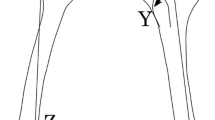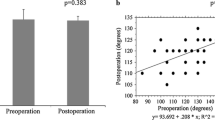Abstract
Purpose
Tibiofemoral synchronization technique matches the rotational alignment of the tibial component to the femoral component during the total knee arthroplasty (TKA). The rotational axis of the proximal tibia can be changed by this technique, which affects tibial torsion postoperatively. The purpose of this study was to investigate whether the tibiofemoral synchronization technique affect the tibial torsion, and the lower limb rotation after primary TKA. It was hypothesised that the tibial torsion would change after primary TKA.
Methods
Ninety-three posterior stabilised TKAs from 89 patients were included from January 2017 to December 2018. Mechanical hip–knee–ankle axis (mHKA), in plain radiographs, femoral anteversion, tibial torsion, femoral neck-malleolar angle (FNMA), and rotational alignment of the femoral and the tibial components in pre- and postoperative CT scans were measured by two blinded observers. The primary outcome was a postoperative change in femoral anteversion, tibial torsion and FNMA. Clinical outcomes were evaluated using the American Knee Society Knee Score (AKSKS)/Function Score (AKSFS), and Oxford Knee Score (OKS) preoperatively and at 1 year after TKA. Patients’ perception of changes in the foot progression angle after TKA was investigated. Statistical significance was set at p < 0.05.
Results
The mean rotational mismatch between the femoral and the tibial component was 0.6 ± 3.2°. There was a significant decrease in femoral anteversion (9.5 ± 6.7° vs. 5.2 ± 6.6°, p < 0.001), and a significant increase in the FNMA (17.6 ± 9.7° vs. 21.8 ± 10.5°, p = 0.005) after TKA, while no significant change in tibia torsion was observed (25.4 ± 8.8° vs. 24.9 ± 9.3°, p = 0.739). AKSS (37.8 ± 15.1 vs. 92.8 ± 8.8, p < 0.001), AKSFS (53.9 ± 18.1 vs. 89.9 ± 5.3, p < 0.001), and OKS (18.0 ± 7.3 vs. 39.9 ± 4.8, p < 0.001) were significantly improved at 1 year after TKA. Ten knees (11%) had changes in tibial torsion greater than ± 10° postoperatively. Four of five patients who had changes in FNMA greater than 15° perceived the external rotation of the foot progression angle after TKA. All four patients had an increase in tibial torsion larger than 10°.
Conclusion
Our study shows that the tibiofemoral synchronization technique less likely affects the tibial torsion after primary TKA.



Similar content being viewed by others
References
Aglietti P, Sensi L, Cuomo P, Ciardullo A (2008) Rotational position of femoral and tibial components in TKA using the femoral transepicondylar axis. Clin Orthop Relat Res 466:2751–2755
Akagi M, Mori S, Nishimura S, Nishimura A, Asano T, Hamanishi C (2005) Variability of extraarticular tibial rotation references for total knee arthroplasty. Clin Orthop Relat Res 436:172–176
Akagi M, Oh M, Nonaka T, Tsujimoto H, Asano T, Hamanishi C (2004) An anteroposterior axis of the tibia for total knee arthroplasty. Clin Orthop Relat Res 420:213–219
Berhouet J, Beaufils P, Boisrenoult P, Frasca D, Pujol N (2011) Rotational positioning of the tibial tray in total knee arthroplasty: a CT evaluation. Orthop Traumatol Surg Res 97:699–704
Dalury DF (2001) Observations of the proximal tibia in total knee arthroplasty. Clin Orthop Relat Res 389:150–155
Eun IS, Kim OG, Kim CK, Lee HS, Lee JS (2013) Validation of the Korean version of the Oxford knee score in patients undergoing total knee arthroplasty. Clin Orthop Relat Res 471:600–605
Fang CH, Cheng CK, Qu TB, Zhang JH, Zhang B, Hua Q, Yan SG (2019) The posterolateral corner-locked technique Is applicable in a Chinese population regarding the tibial component rotation alignment in total knee arthroplasty. J Knee Surg 5:466–473
Fowler JR, Ilyas AM (2011) The accuracy of digital radiography in orthopaedic applications. Clin Orthop Relat Res 469:1781–1784
Hauschild O, Muenzberg M, Knothe D, Konstantinidis L, Helwig P, Sudkamp NP, Thielemann FW (2013) Rotational limb alignment changes following total knee arthroplasty. Knee Surg Sports Traumatol Arthrosc 21:2346–2354
Hirakawa M, Miyazaki M, Ikeda S, Matsumoto Y, Kondo M, Tsumura H (2017) Evaluation of the rotational alignment of the tibial component in total knee arthroplasty: position prioritizing maximum coverage. Eur J Orthop Surg Traumatol 27:119–124
Huddleston JI, Scott RD, Wimberley DW (2005) Determination of neutral tibial rotational alignment in rotating platform TKA. Clin Orthop Relat Res 440:101–106
Ikeuchi M, Yamanaka N, Okanoue Y, Ueta E, Tani T (2007) Determining the rotational alignment of the tibial component at total knee replacement: a comparison of two techniques. J Bone Joint Surg Br 89:45–49
Jung WH, Seo JG, Kim DH, Balabadra S, Mandot U, Kumar D (2020) Optimal rotational positioning of tibial component in total knee arthroplasty: determined by linker surgical technique using a high definition CT. Arch Orthop Trauma Surg 140:401–408
Khan MS, Seon JK, Song EK (2012) Rotational profile of lower limb and axis for tibial component alignment in varus osteoarthritic knees. J Arthroplasty 27:797–802
Kim CW, Seo SS, Kim JH, Roh SM, Lee CR (2014) The anteroposterior axis of the tibia in Korean patients undergoing total knee replacement. Bone Joint J 96:1485–1490
Kim JI, Jang J, Lee KW, Han HS, Lee S, Lee MC (2017) Anterior tibial curved cortex is a reliable landmark for tibial rotational alignment in total knee arthroplasty. BMC Musculoskelet Disord 18:252
Lee DH, Seo JG, Moon YW (2008) Synchronisation of tibial rotational alignment with femoral component in total knee arthroplasty. Int Orthop 32:223–227
Liodakis E, Aljuneidi W, Krettek C, Ettinger M, Kenawey M (2011) The neck-malleolar angle: an alternative method for measuring total lower limb torsion that considers the knee joint rotation angle. Skeletal Radiol 40:617–621
Maderbacher G, Baier C, Springorum HR, Maderbacher H, Birkenbach AM, Benditz A, Grifka J, Keshmiri A (2017) Impact of axial component alignment in total knee arthroplasty on lower limb rotational alignment: an in vitro study. J Knee Surg 30:372–377
Saffarini M, Nover L, Tandogan R, Becker R, Moser LB, Hirschmann MT, Indelli PF (2019) The original Akagi line is the most reliable: a systematic review of landmarks for rotational alignment of the tibial component in TKA. Knee Surg Sports Traumatol Arthrosc 27:1018–1027
Shih YC, Chau MM, Arendt EA, Novacheck TF (2020) Measuring lower extremity rotational alignment: a review of methods and case studies of clinical applications. J Bone Joint Surg Am 102:343–356
Shukla S, Upadhyaya V, Goel M, Gupta S (2019) Antero-posterior axis of tibia in patient undergoing total knee replacement in Indian population. J Clin Orthop Trauma 10:96–101
Tao K, Cai M, Zhu Y, Lou L, Cai Z (2014) Aligning the tibial component with medial border of the tibial tubercle–is it always right? Knee 21:295–298
Tsukeoka T, Lee TH, Tsuneizumi Y, Suzuki M (2014) The tibial crest as a practical useful landmark in total knee arthroplasty. Knee 21:283–289
Ueyama H, Minoda Y, Sugama R, Ohta Y, Yamamura K, Nakamura S, Takemura S, Nakamura H (2020) Malrotation of the fixed-bearing posterior stabilized total knee prosthesis causes a postoperative rotational mismatch between the femur and tibia. Knee Surg Sports Traumatol Arthrosc 28:3810–3820
Valkering KP, Breugem SJ, van den Bekerom MP, Tuinebreijer WE, van Geenen RC (2015) Effect of rotational alignment on outcome of total knee arthroplasty. Acta Orthop 86:432–439
Acknowledgements
The authors thank Editage (www.editage.co.kr) for English-language editing.
Funding
We did not receive outside funding related to this study.
Author information
Authors and Affiliations
Contributions
JHB: study concepts/design and manuscript drafting/revision, JWL: data acquisition/analysis, SHK: data acquisition/analysis, SGK: data acquisition/analysis and manuscript revision, YSJ: data acquisition/analysis and manuscript revision, and JSC: data acquisition/analysis and manuscript revision. All the authors read and approved the final manuscript.
Corresponding author
Ethics declarations
Conflict of interest
Each author certifies that he has no commercial associations (e.g. consultancies, stock ownership, equity interest, and patent/licensing arrangements) that might pose a conflict of interest in connection with the submitted article.
Ethical approval
This study was approved by the institutional ethical review board (2016GR0311).
Informed consent
The informed consent was obtained from each patient.
Additional information
Publisher's Note
Springer Nature remains neutral with regard to jurisdictional claims in published maps and institutional affiliations.
Rights and permissions
About this article
Cite this article
Bae, J.H., Lee, JW., Kim, SH. et al. Femoral matched tibia component rotation has little effect on the tibial torsion after total knee arthroplasty. Knee Surg Sports Traumatol Arthrosc 30, 698–704 (2022). https://doi.org/10.1007/s00167-020-06429-z
Received:
Accepted:
Published:
Issue Date:
DOI: https://doi.org/10.1007/s00167-020-06429-z




